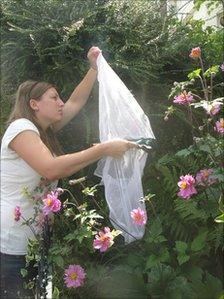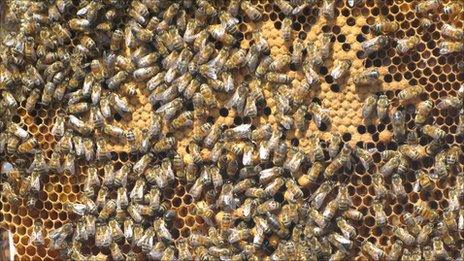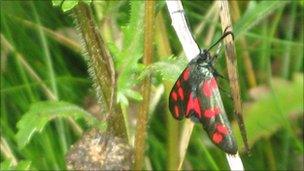Cities could be the key to saving pollinating insects
- Published
Professor Jane Memmott on how an urban street can be an insect haven
"Some people do think we're a little odd," says Professor Jane Memmott, as she rummages around in someone's front garden, hunting for plants and insects.
"But once we explain what we're doing - and we do ask for permission to do this - people are generally very interested."
Professor Memmott and her team, from the University of Bristol, are in a typical residential street just outside of the centre of Bristol.
They are gathering data for a Britain-wide survey, which will provide a snapshot of the number of insect pollinators - bees, butterflies, beetles and flies - that can be found in an urban area like this.
To do this, they are sweeping along a transect - a 1km-long straight line - across the city, and stopping every 10m to count and identify the number of flowers and pollinators they find.

A front garden can offer an array of floral delights for pollinators
It does not matter if it is a car park, roundabout or a residential street like the one they are looking at today - every patch that falls along this line is being scrutinised.
This mammoth task is being repeated in 12 cities all over Britain - from Dundee in the north to Southampton in the south.
Then in addition to these urban centres, the team is carrying out exactly the same survey in 12 farmland habitats and 12 nature reserves, also spread out across the length and breadth of Britain.
Dr Katherine Baldock, from the University of Bristol, who is managing the project, says: "The project is probably the largest field study ever of pollinators and their habitats in the UK.
"It's a huge logistical challenge."
It will show for the first time how these different habitats compare.
Professor Memmott explains: "We are asking: where are pollinators in the UK? Are they in urban habitats, are they in farmlands or are they in nature reserves?
"To find this out, you need to really sample all of those habitats in the same way, which together make up about 98% of the surface area of the UK."
Concrete jungle
While the urban sprawl has been linked to declines in wildlife, the researchers suspect that cities may offer an unlikely haven for these essential insects.

Oil seed rape is attractive to pollinators over a brief period of time
"Cities can be good because they contain a huge diversity of sites: you've got gardens, you've got meadows, you've got nature reserves," says Professor Memmott.
"All of these habitats are jimmied together, and they can add up to a really special resource for pollinators."
Gardeners help too, she says. The residential street in Bristol that is being surveyed reveals an eclectic array of plants - from carefully planted lavender to pockets of weeds like toad-flax - and plenty of insects buzzing about and pollinating them.
In contrast, farmland habitats can offer a feast and famine situation for insects: when a crop such as oil seed rape is in flower, pollinators will flock, but once the bloom is over, there is little there for them.
And in nature reserves, the researchers think that plant choice may be limited too.
Professor Memmott explains: "There's a greater diversity and abundance of flowers in cities than there probably is in nature reserves and the countryside.
"The flowering season is longer, because gardeners love things that flower really early and flower really late, so there's forage over a longer period of time. And my gut feeling is that this is probably more of a reliable source of food."

Bees have suffered massive declines in numbers
Eighty percent of British plant species depend on insect pollination - and many of these are key food crops.
But there has been a dramatic decline in pollinator numbers in recent years, which has been linked to environmental changes, pests and disease.
One species that has been particularly badly hit is the bee.
Tim Lovett, from the British Beekeepers Association, says: "We have concerns about the decline in insect pollinators.
"And if you track it, over the last 30 or 40 years, the number of bee keepers has declined, the number of hives has declined - and there must be a tipping point when you don't have enough pollinators to carry out the job that they do."

Patches of wildflowers in cities can attract moths like this
But, he adds, bees can - and do - thrive in the city, as a recent increase in urban bee keepers has shown.
The scientists carrying out the survey say that finding out where pollinating insects are doing well could help to boost their numbers.
And if it is the city, then the team says there is much that can be done to make our concrete jungles even more attractive to these vital insects.
"We want to make a really big difference to the lives of pollinators: to up their diversity and abundance in cities," explains Professor Memmott.
"If we know what is limiting them, we stand a chance of fixing that - we can add more food, and more resources to cities to make a difference.
"If everyone did their bit, it could make quite a difference to what people find in cities."
The University of Bristol study, which is taking place over the next three years, is part of the £10m Insect Pollinators Initiative, which is funded by the Biotechnology and Biological Sciences Research Council, the Natural Environment Research Council, Defra, The Wellcome Trust and the Scottish Government.

- Published12 April 2011
- Published25 November 2010
- Published22 June 2010
- Published15 October 2010
- Published17 June 2011
- Published18 October 2010